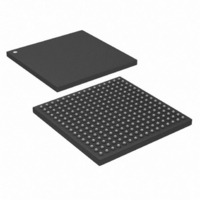DS26528G+ Maxim Integrated Products, DS26528G+ Datasheet - Page 59

DS26528G+
Manufacturer Part Number
DS26528G+
Description
IC TXRX T1/E1/J1 OCT 256-CSBGA
Manufacturer
Maxim Integrated Products
Type
Transceiverr
Datasheet
1.DS26528G.pdf
(276 pages)
Specifications of DS26528G+
Number Of Drivers/receivers
4/4
Protocol
IEEE 1149.1
Voltage - Supply
3.135 V ~ 3.465 V
Mounting Type
Surface Mount
Package / Case
256-CSBGA
Lead Free Status / RoHS Status
Lead free / RoHS Compliant
- Current page: 59 of 276
- Download datasheet (2Mb)
8.9.7.1 Status and Information Bit Operation
When a particular event has occurred (or is occurring), the appropriate bit in one of these registers is set to 1.
Status bits can operate in either a latched or real-time fashion. Some latched bits can be enabled to generate a
hardware interrupt via the INTB signal.
8.9.7.1.1 Real-Time Bits
Some status bits operate in a real-time fashion. These bits are read-only and indicate the present state of an alarm
or a condition. Real-time bits remain stable and valid during the host read operation. The current value of the
internal status signals can be read at any time from the real-time status registers without changing any the latched
status register bits.
8.9.7.1.2 Latched Bits
When an event or an alarm occurs and a latched bit is set to 1, it remains set until cleared by the user. These bits
typically respond on a change-of-state for an alarm, condition, or event, and operate in a read-then-write fashion.
The user should read the value of the desired status bit and then write a 1 to that particular bit location to clear the
latched value (write a 0 to locations not to be cleared). Once the bit is cleared, it is not set again until the event has
occurred again.
8.9.7.1.3 Mask Bits
Some of the alarms and events can be either masked or unmasked from the interrupt pin via the Receive Interrupt
Mask registers (RIM1:RIM7). When unmasked, the INTB signal is forced low when the enabled event or condition
occurs. The INTB pin is allowed to return high (if no other unmasked interrupts are present) when the user reads
and then clears (with a write) the alarm bit that caused the interrupt to occur. Note that the latched status bit and
the INTB pin clear even if the alarm is still present.
Note that some conditions can have multiple status indications. For example, receive loss of frame (RLOF)
provides the following indications:
RRTS1.0
(RLOFD)
(RLOFC)
(RLOF)
RLS1.0
RLS1.4
Real-time indication that the receiver is not synchronized with
incoming data stream. Read-only bit that remains high as long as
the condition is present.
Latched indication that the receiver has lost synchronization since
the bit was last cleared. Bit clears when written by the user, even
if the condition is still present (rising edge detect of RRTS1.0).
Latched indication that the receiver has reacquired
synchronization since the bit was last cleared. Bit clears when
written by the user, even if the condition is still present (falling
edge detect of RRTS1.0).
59 of 276
DS26528 Octal T1/E1/J1 Transceiver
Related parts for DS26528G+
Image
Part Number
Description
Manufacturer
Datasheet
Request
R

Part Number:
Description:
MAX7528KCWPMaxim Integrated Products [CMOS Dual 8-Bit Buffered Multiplying DACs]
Manufacturer:
Maxim Integrated Products
Datasheet:

Part Number:
Description:
Single +5V, fully integrated, 1.25Gbps laser diode driver.
Manufacturer:
Maxim Integrated Products
Datasheet:

Part Number:
Description:
Single +5V, fully integrated, 155Mbps laser diode driver.
Manufacturer:
Maxim Integrated Products
Datasheet:

Part Number:
Description:
VRD11/VRD10, K8 Rev F 2/3/4-Phase PWM Controllers with Integrated Dual MOSFET Drivers
Manufacturer:
Maxim Integrated Products
Datasheet:

Part Number:
Description:
Highly Integrated Level 2 SMBus Battery Chargers
Manufacturer:
Maxim Integrated Products
Datasheet:

Part Number:
Description:
Current Monitor and Accumulator with Integrated Sense Resistor; ; Temperature Range: -40°C to +85°C
Manufacturer:
Maxim Integrated Products

Part Number:
Description:
TSSOP 14/A°/RS-485 Transceivers with Integrated 100O/120O Termination Resis
Manufacturer:
Maxim Integrated Products

Part Number:
Description:
TSSOP 14/A°/RS-485 Transceivers with Integrated 100O/120O Termination Resis
Manufacturer:
Maxim Integrated Products

Part Number:
Description:
QFN 16/A°/AC-DC and DC-DC Peak-Current-Mode Converters with Integrated Step
Manufacturer:
Maxim Integrated Products

Part Number:
Description:
TDFN/A/65V, 1A, 600KHZ, SYNCHRONOUS STEP-DOWN REGULATOR WITH INTEGRATED SWI
Manufacturer:
Maxim Integrated Products

Part Number:
Description:
Integrated Temperature Controller f
Manufacturer:
Maxim Integrated Products

Part Number:
Description:
SOT23-6/I°/45MHz to 650MHz, Integrated IF VCOs with Differential Output
Manufacturer:
Maxim Integrated Products

Part Number:
Description:
SOT23-6/I°/45MHz to 650MHz, Integrated IF VCOs with Differential Output
Manufacturer:
Maxim Integrated Products

Part Number:
Description:
EVALUATION KIT/2.4GHZ TO 2.5GHZ 802.11G/B RF TRANSCEIVER WITH INTEGRATED PA
Manufacturer:
Maxim Integrated Products

Part Number:
Description:
QFN/E/DUAL PCIE/SATA HIGH SPEED SWITCH WITH INTEGRATED BIAS RESISTOR
Manufacturer:
Maxim Integrated Products
Datasheet:










